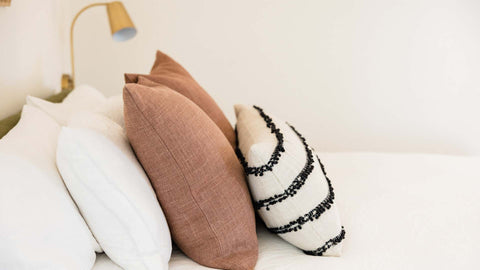Sleep apnea can significantly impact your quality of life, making restful nights elusive. Choosing the right pillow is a crucial step in managing this sleep disorder and improving your sleep quality. While CPAP therapy remains the primary treatment, a suitable pillow can complement your efforts to alleviate symptoms and enhance comfort.
The Good Pillow stands out as the best pillow for sleep apnea in 2024 due to its adjustable design. This versatility allows you to tailor the pillow's firmness and height to your specific needs, accommodating various sleeping positions and CPAP mask types. By providing proper support and alignment, it helps keep your airways open, potentially reducing snoring and improving oxygen flow.
For those who prefer an elevated sleeping position, wedge pillows like the Helix Wedge Pillow offer another effective option. Its gradual slope can help reduce acid reflux and post-nasal drip, which may exacerbate sleep apnea symptoms. When selecting a pillow, consider factors such as your preferred sleeping position, any additional health concerns, and compatibility with your CPAP equipment to ensure the best possible sleep experience.
Evaluating Pillows for Sleep Apnea
Choosing the right pillow can significantly impact your sleep quality and manage sleep apnea symptoms. The ideal pillow promotes proper alignment and supports your sleeping position.
Understanding Sleep Apnea and Its Implications
Sleep apnea is a condition where breathing repeatedly stops and starts during sleep. It can lead to poor sleep quality, daytime fatigue, and other health issues. The right pillow can help keep your airway open and reduce snoring.
For those with obstructive sleep apnea (OSA), pillow selection is crucial. Your pillow should support proper neck and spinal alignment to maintain an open airway throughout the night.
CPAP users need pillows that accommodate their masks without compromising comfort or seal.
Factors to Consider in Pillows for Different Sleeping Styles
Your sleeping position plays a key role in pillow selection. Side sleepers often benefit from firmer, higher-loft pillows to maintain neck alignment. Back sleepers typically need medium-loft pillows for proper support.
Stomach sleepers should opt for thin, soft pillows to minimize neck strain. Combination sleepers may prefer adjustable pillows that adapt to position changes.
Consider pillows with adjustable loft or customizable fill to fine-tune your support. Memory foam and latex pillows often provide excellent contouring and pressure relief.
Materials and Types of Sleep Apnea Pillows
Several pillow types cater to sleep apnea sufferers:
- Wedge pillows: Elevate your upper body to reduce snoring and improve breathing
- CPAP pillows: Feature cutouts to accommodate CPAP masks
- Cervical pillows: Support neck curvature for improved airway alignment
Memory foam pillows offer contouring support and are popular for their pressure-relieving properties. Latex pillows provide similar benefits with added breathability.
Hypoallergenic materials like down alternative can be beneficial for those with allergies. Look for pillows with cooling features if you tend to sleep hot.
Consider pillows with trial periods to ensure they meet your needs. Quality materials and construction contribute to longevity and consistent support.
Complementary Strategies and Considerations
Selecting the right pillow is just one part of managing sleep apnea effectively. Combining pillow choice with other strategies can significantly improve your sleep quality and overall health.
Managing Sleep Apnea Symptoms Beyond Pillow Choice
Weight loss can reduce the severity of obstructive sleep apnea (OSA). Even a modest reduction in body weight may alleviate pressure on your airways. Regular exercise also improves sleep quality and reduces daytime fatigue.
Avoid alcohol and sedatives before bedtime, as they can relax throat muscles and worsen snoring. Sleeping on your side instead of your back can help keep airways open.
Consider using a CPAP machine as prescribed by your doctor. Modern CPAP masks are designed for comfort and can be used with specialized pillows to prevent air leaks.
Elevating the head of your bed by 4-6 inches may help reduce snoring and improve breathing during sleep.
Pillow Selection for Long-Term Health and Comfort
Choose a pillow that supports your preferred sleeping position while accommodating CPAP equipment if needed. Side sleepers often benefit from firmer, higher pillows to keep the neck aligned.
Memory foam pillows can provide consistent support and pressure relief. Look for pillows with cooling properties if you tend to sleep hot.
For CPAP users, specialized pillows with cut-outs for masks can minimize air leaks and improve comfort. The Lunderg CPAP Pillow is designed specifically for this purpose.
Consider a pillow like Good Pillow if you also suffer from acid reflux. These can help position your upper body at an angle that reduces both reflux and snoring.
Replace your pillow every 1-2 years to maintain optimal support and hygiene. A high-quality pillow is an investment in your health and sleep quality.


